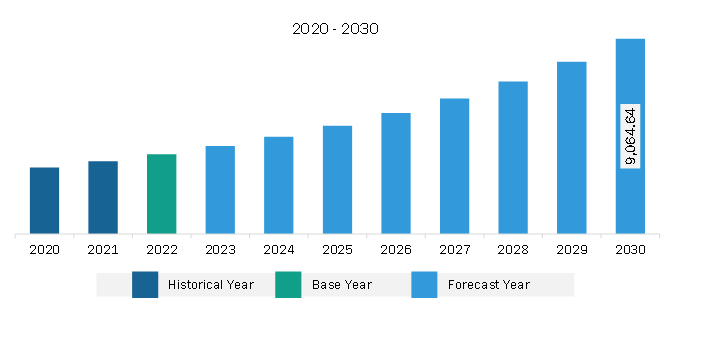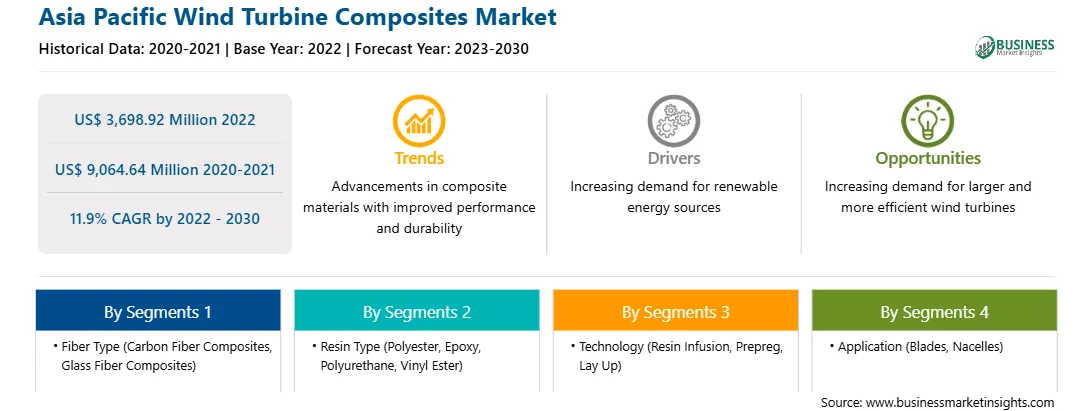The Asia Pacific wind turbine composites market was valued at US$ 3,698.92 million in 2022 and is expected to reach US$ 9,064.64 million by 2030; it is estimated to record a CAGR of 11.9% from 2022 to 2030.
Adoption of Natural Fiber Reinforced Polymer (NFRP) Composites Boosts Asia Pacific Wind Turbine Composites Market
A wind turbine consists of several parts such as a hub, gearbox, blades, nacelle, and tower, among which wind turbine blades and nacelle are generally composed of composite materials, including glass and carbon fibers. However, these kinds of fibers are often associated with a certain set of limitations, which include their availability, nonbiodegradability, harmful impact on health, and the fabrication cost involved. The use of natural fibers can overcome all these challenges. The growing environmental issues have shifted the attention of researchers and technologists to the use of natural biodegradable materials, which has bolstered the use of natural fiber-reinforced polymer (NFRP) composites in wind turbine manufacturing.
Natural fibers are defined as those substances which are made from plants, animals, and minerals with the help of geological processes. Natural fibers obtained from kenaf, bagasse, banana, sisal, flax, hemp, jute, abaca, and bamboo are easily available and need low processing costs. They can be spun together into filaments, threads, or ropes and can be knitted, woven, or matted.
The characteristic features of natural fibers might vary considerably according to their chemical composition and structure; fiber type; and fiber's growing conditions, harvesting time, manufacturing method, treatment, and storage processes. Such reinforced composites form a class of materials that exhibit superior mechanical features as well as potentially replace the conventional material systems in wind turbines.
The NFRP composites possess certain advantages as compared to synthetic fiber-reinforced composites. These benefits include low density, minimal cost, nonabrasive features, biodegradability, and renewable nature. Hence, the rising concern and awareness about the social and environmental impacts of conventional materials are resulting in the shift toward environment-friendly materials by manufacturers of composites, which is expected to fuel the wind turbine composites market growth during the forecast period.
Asia Pacific Wind Turbine Composites Market Overview
The wind turbine composites market in Asia Pacific is segmented into Australia, China, India, Japan, South Korea, and the Rest of Asia Pacific. China is a major contributor to the market growth in this region. The country has been the largest and fastest-growing renewable energy producer for more than a decade across the world. Moreover, it has the world's largest wind energy market. China remained the world's largest market for new onshore additions in 2020, driven by the feed-in tariff (FiT) cut-off. The wind power industry in India also records a remarkable growth due to policies and regulations adopted by the union and state governments. In Japan, the government has set the target of 10 GW of offshore wind installation by 2030 and 30-45 GW by 2040. According to the IEA Wind TCP, Japan's wind power capacity reached 4,581 MW in the end of 2021. The Japan Wind Power Association stated that the country installed 232.9 MW of new wind capacity in 2022, bringing the total capacity in operation to 4,802 MW. Thus, the increasing installed wind capacity in China, Japan, India, Australia, and others drives the demand for wind turbine composites. Countries such as Taiwan, South Korea, Vietnam, and the Philippines are also taking various initiatives to install new wind capacities, adding to the region's demand for wind turbine composites.
Asia Pacific Wind Turbine Composites Market Revenue and Forecast to 2030 (US$ Million)

Strategic insights for the Asia Pacific Wind Turbine Composites provides data-driven analysis of the industry landscape, including current trends, key players, and regional nuances. These insights offer actionable recommendations, enabling readers to differentiate themselves from competitors by identifying untapped segments or developing unique value propositions. Leveraging data analytics, these insights help industry players anticipate the market shifts, whether investors, manufacturers, or other stakeholders. A future-oriented perspective is essential, helping stakeholders anticipate market shifts and position themselves for long-term success in this dynamic region. Ultimately, effective strategic insights empower readers to make informed decisions that drive profitability and achieve their business objectives within the market.

| Report Attribute | Details |
|---|---|
| Market size in 2022 | US$ 3,698.92 Million |
| Market Size by 2030 | US$ 9,064.64 Million |
| Global CAGR (2022 - 2030) | 11.9% |
| Historical Data | 2020-2021 |
| Forecast period | 2023-2030 |
| Segments Covered |
By Fiber Type
|
| Regions and Countries Covered | Asia-Pacific
|
| Market leaders and key company profiles |
The geographic scope of the Asia Pacific Wind Turbine Composites refers to the specific areas in which a business operates and competes. Understanding local distinctions, such as diverse consumer preferences (e.g., demand for specific plug types or battery backup durations), varying economic conditions, and regulatory environments, is crucial for tailoring strategies to specific markets. Businesses can expand their reach by identifying underserved areas or adapting their offerings to meet local demands. A clear market focus allows for more effective resource allocation, targeted marketing campaigns, and better positioning against local competitors, ultimately driving growth in those targeted areas.

1. Avient Corp
2. Toray Industries Inc
3. SGL Carbon SE
4. Owens Corning
5. Gurit Holding AG
6. Covestro AG - Global
7. Hexion Inc - Global
8. Hexcel Corp
9. Exel Composites Oyj
The Asia Pacific Wind Turbine Composites Market is valued at US$ 3,698.92 Million in 2022, it is projected to reach US$ 9,064.64 Million by 2030.
As per our report Asia Pacific Wind Turbine Composites Market, the market size is valued at US$ 3,698.92 Million in 2022, projecting it to reach US$ 9,064.64 Million by 2030. This translates to a CAGR of approximately 11.9% during the forecast period.
The Asia Pacific Wind Turbine Composites Market report typically cover these key segments-
The historic period, base year, and forecast period can vary slightly depending on the specific market research report. However, for the Asia Pacific Wind Turbine Composites Market report:
The Asia Pacific Wind Turbine Composites Market is populated by several key players, each contributing to its growth and innovation. Some of the major players include:
The Asia Pacific Wind Turbine Composites Market report is valuable for diverse stakeholders, including:
Essentially, anyone involved in or considering involvement in the Asia Pacific Wind Turbine Composites Market value chain can benefit from the information contained in a comprehensive market report.